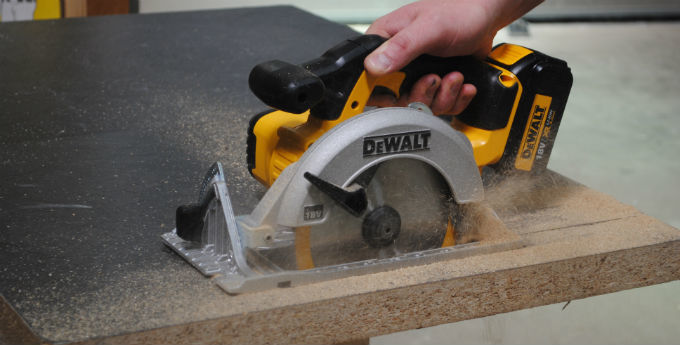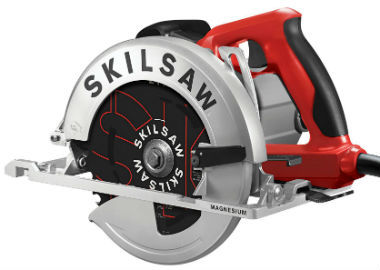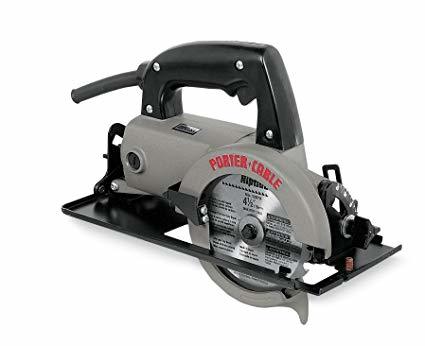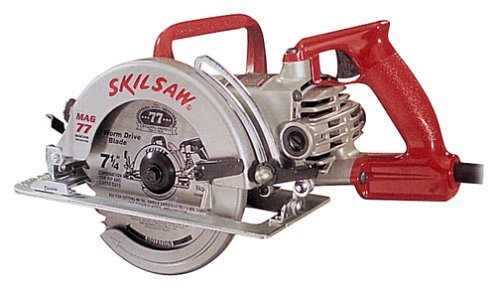
Circular saws have one job they can do, and they do it really well – cutting. Fitted with the appropriate blade, it’s hard to beat a circular saw when it comes to making clean, precise and straight cuts on wood, tile, masonry, and even steel.
It’s a power tool that has seen its design refined to an extent that almost all manufacturers have tacitly agreed on the classic circular saw design, with little variations.
How to Choose the Right Type of Circular Saw
There are not a whole lot of styles to choose from when it comes to circular saws – the choice basically boils down to whether you want an inline saw, or a worm drive circular saw, cordless or corded.
Regardless of the type of circular saw you choose, most models will come with the basic components. These are baseline features you are looking for – if for some reason a model does not have one of these, consider something else.
- The blade guard, like its name, says, protects the blade when the saw is not in use.
Most blade guards are lightly loaded with a spring that lets the user pull it off the blade as the saw is pushed against the stock. Like angle grinder guards, most circular saw blade guards are removable. - The foot plate or shoe makes it possible to make steady, straight cuts by bracing the saw against the wood, tile or masonry.
- Bevel and depth adjustments let you raise, lower or tilt the shoe to make straight or slanting cuts of various thicknesses.
When considering a circular saw, do take note that it can only cut to a rated depth or thickness, depending on the diameter of the blade that it will take and the maximum depth adjustment.
If your project needs you to cut pieces more than four inches thick, consider getting a miter saw instead.
Inline Circular Saws / Sidewinder Saws
Inline saws, also known as sidewinders, have their motors mounted on the same axis as the shaft that drives a blade – like an oversized angle grinder.
This is the classic form factor of the circular saw, and what people generally think of when the topic of circular saws come up.

skil.com
They are more compact and weigh less than an equivalent worm drive saw, and they are generally cheaper to buy, as well. Most corded sidewinder models weigh around 11 pounds or less.
Features to look for
- Tool-free adjustment features let you adjust for depth and bevel without having to open a toolbox.
- Blades included with the circular saw lets you use the tool right away – even better if the unit comes with the more durable carbide blades.
- Electric brakes run the motor back when you release the trigger, making the blade stop in a manner of seconds.
It’s always advisable to wait for the blade to stop spinning before you move the stock material, and this feature lets you be more productive by letting you move on to the next step faster. - Spindle or shaft locks make it safer and easier to change the saw blade.
- Laser guides shine a beam of laser light on the workpiece, giving you a visual cue of where the blade is going to cut beforehand. Very helpful for some people and not preferred by others.
Sidewinder saws are great at cutting seasoned wood and boards, making them a versatile tool in the wood workshop.
They are generally less powerful than worm drive saws, although some of the higher end models come with motors and gearing that put out enough torque to compete with the bigger and beefier worm drive saws.
Standard sized inline saws will usually accept 7 1/4-inch diameter blades – the most common in the market. There are lightweight models that are designed to be more maneuverable and weigh less than eight pounds, as well and may use a smaller blade, so keep that in mind.
Trim Saws
Sometimes, maneuverability is just too important that giving up cutting power is worth it.
Trim saws, so called for their preferred use as tools for paneling, finish work and cutting trim, can only take blades 4 1/2 inches in diameter or smaller.

portercable.com
The smaller, more lightweight saw allows for more control and more precision in most cases and usually the materials that a trim saw is used for is not that thick so the smaller blade diameter is usually not an issue.
Features to Look For
- Multiple batteries included with the cordless models can keep you productive for longer. Circular saws are very power-hungry tools and they can go through battery power rather quickly. Higher Ah batteries are a must!
- Convenient trigger switch lets you turn on and push the trim saw with just one hand
- Lightweight materials keep the weight down so you can keep cutting with your circular saw all day, even while up in ladders or scaffolding.
- Brushless motors are more efficient and will save a bit of battery power for longer run times.
Trim saws can come in both inline and worm drive variants, and a lot of them come in the form of battery-powered models as well. Unlike the traditional circular saw, some trim saws are meant to be gripped with one hand, similar to an angle grinder.
Worm Drive Saws
A worm drive saw has the motor parallel to the shaft, and is not attached directly to it like in the case of inline or sidewinder saws.
Instead, a gear mechanism (the worm drive) transfers power to the shaft. The motor can run faster than the shaft can spin, and the gear drive multiplies the torque.

skil.com
Worm drive circular saws are usually more powerful than the equivalent inline circular saw and have more torque, which is preferred by some.
They are also a bit on the heavy side – 16 pounds for a corded model is the norm, and some of the more heavy duty saws can be heavier. Most worm drive models also require the occasional maintenance, since the gear drive may need oil for lubrication.
Features to Look For
- Easy to access oil ports lets you do maintenance on the worm drive saw faster- even better if it’s a tool-less access port.
- Integrated dust blowers keep sawdust and debris off the workpiece and out of the way.
- Magnesium models can greatly reduce the overall weight of the saw but are usually quite a bit more expensive too.
That said, a worm drive circular saw has the power to cut the stuff that other saws may have trouble with.
For wet lumber, masonry or concrete, a good worm drive saw will not only do the job faster, but the extra torque also keeps the blades cooler. Cool blades stay sharp for longer and are also safer to handle for the operator as well.
Expect to pay more for a nice worm drive saw, though, especially if it’s the cordless variety.
Comparing Circular Saws
When you are comparing circular saws, compare two similar types side by side so you can pick the better one for your price range.
If possible, visit a home improvement store that has display models on the shelves that you can hold to get an overall feel for the saw itself. You won't be able to determine how it cuts but you can see if it is comfortable in your hands.
Circular saws see heavy use in framing projects or in the workshop, and durability is an important consideration as well and often overlooked.
Power and Speed
Like with most power tools, corded circular saws have electric motors rated in Amps (A) while cordless models have theirs rated in terms of Volts (V). These figures indicate the power draw of the motor, and these only give you a rough indication of how the saw will perform under load.
Speed is given in Rotations per Minute (RPM), and most manufacturers site a no-load speed figure.
For cordless and battery-operated models, battery capacity is indicated in volts and are usually 18V models or higher. Ampere-hours (Ah) are also an important metric for cordless saws – the higher the figure, the longer the running time you can expect to get between charges.
Build Materials
Dropping a circular saw is the most common way you can damage it, especially when you overextended on that last push to cut a board. The first component that usually gets dinged in the process is the shoe, as well as the guard.
Aluminum and magnesium shoes are more lightweight and are better for maneuverability, but they can bend if dropped. A cast iron shoe, especially one with reinforcing nibs, can stand up to abuse better at the cost of added weight.
Size
Most corded models will take the standard 7 1/4 inch blade, while some of the more compact models will take the less common 6 1/2 inch. Ultra-compact models or trim saws will take the small 4 1/2 inch blades, which can give you a maximum of 2 inches of cutting depth.
Blades
Like plane cutters, circular saws can use high-speed steel (HSS) blades or carbide-tipped blades. The latter is more expensive, but they retain an edge longer than HSS. Most of the better circular saw models will come with at least one carbide blade included.
Tile-cutting blades are specially designed to cut through ceramic tile, and should not be used for anything else. The same goes for masonry blades designed to grind through concrete and brick.
7 1/4" blades are the most common and are usually the least expensive, for the most part and have the largest variety of blades available. Check out my post on some of the different saw blades out there to get a better idea of which ones to use.

